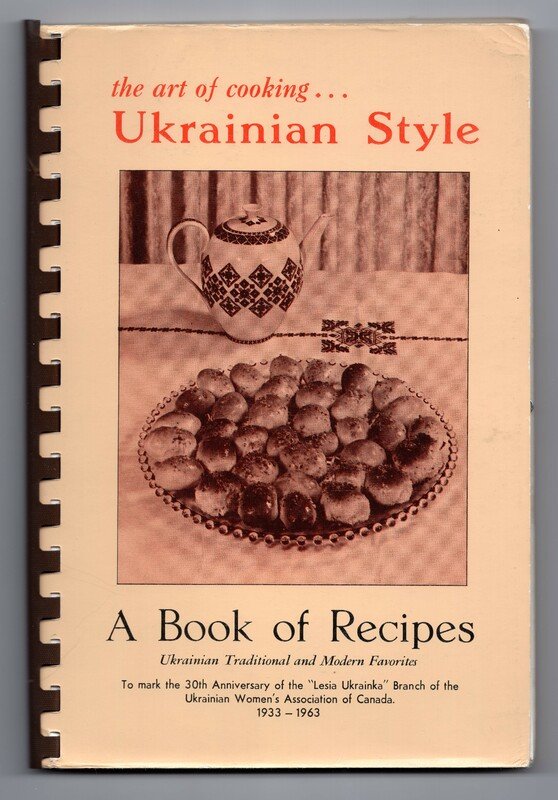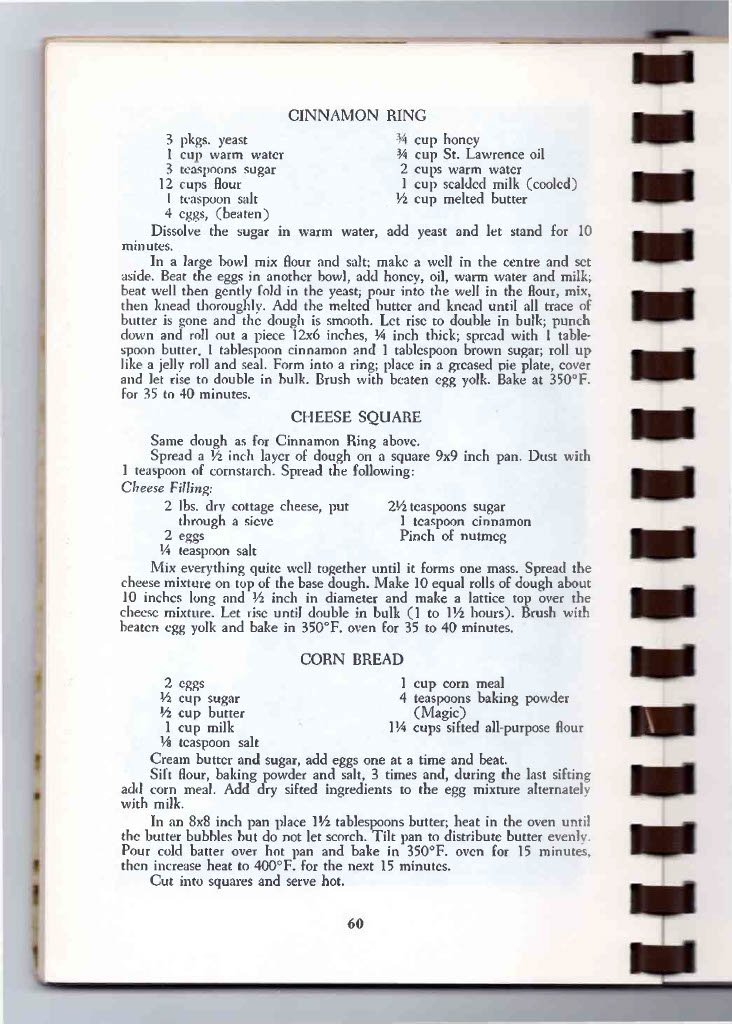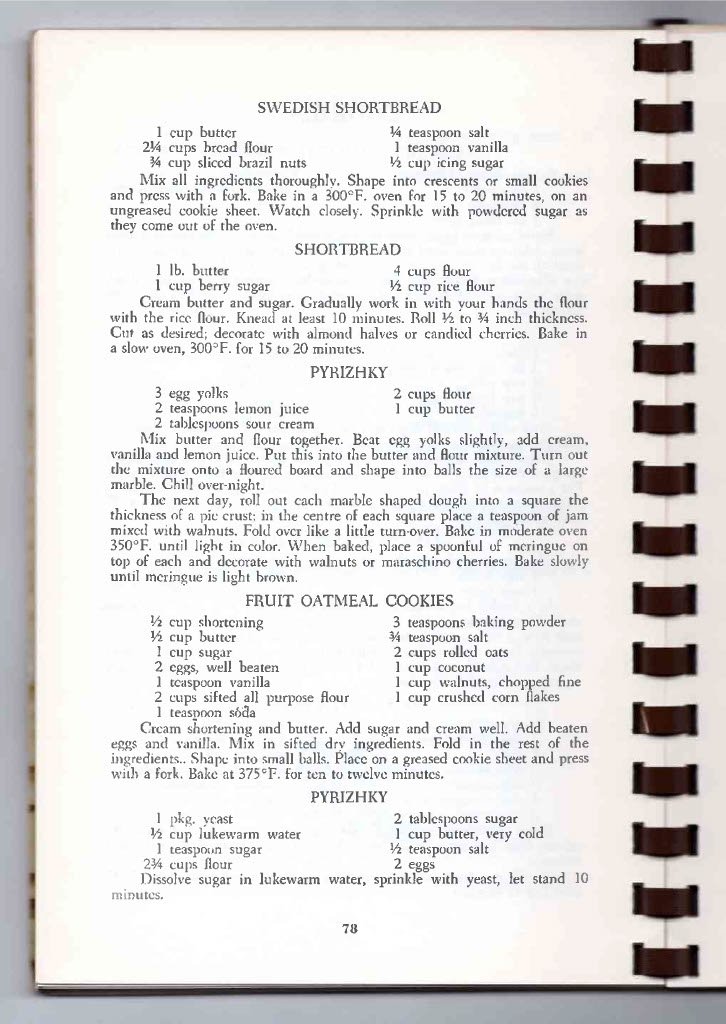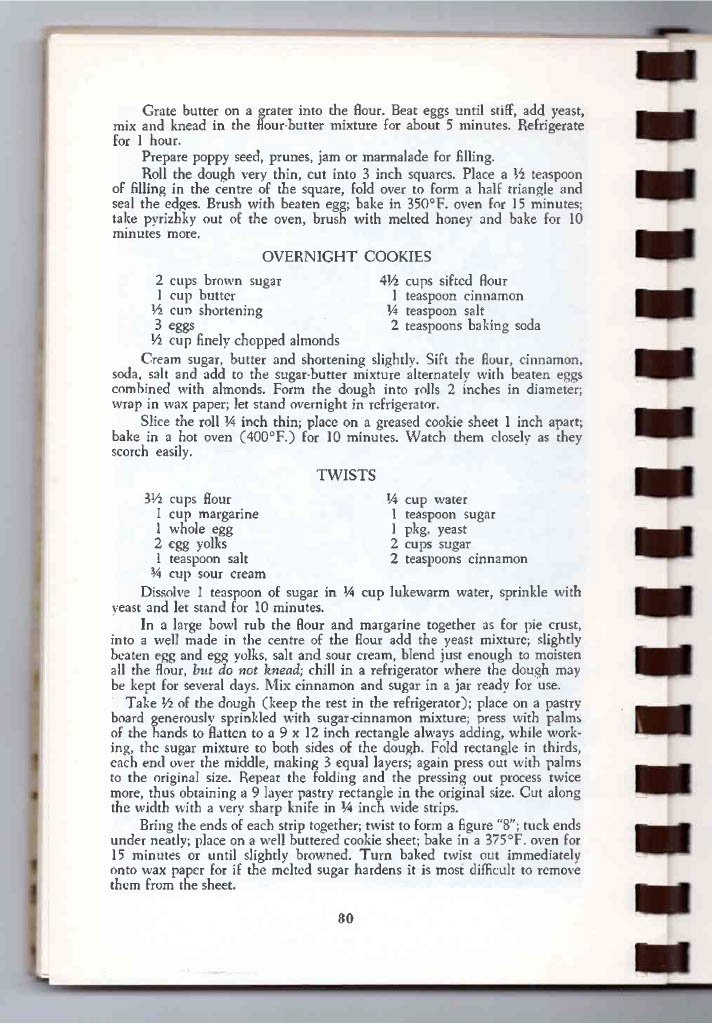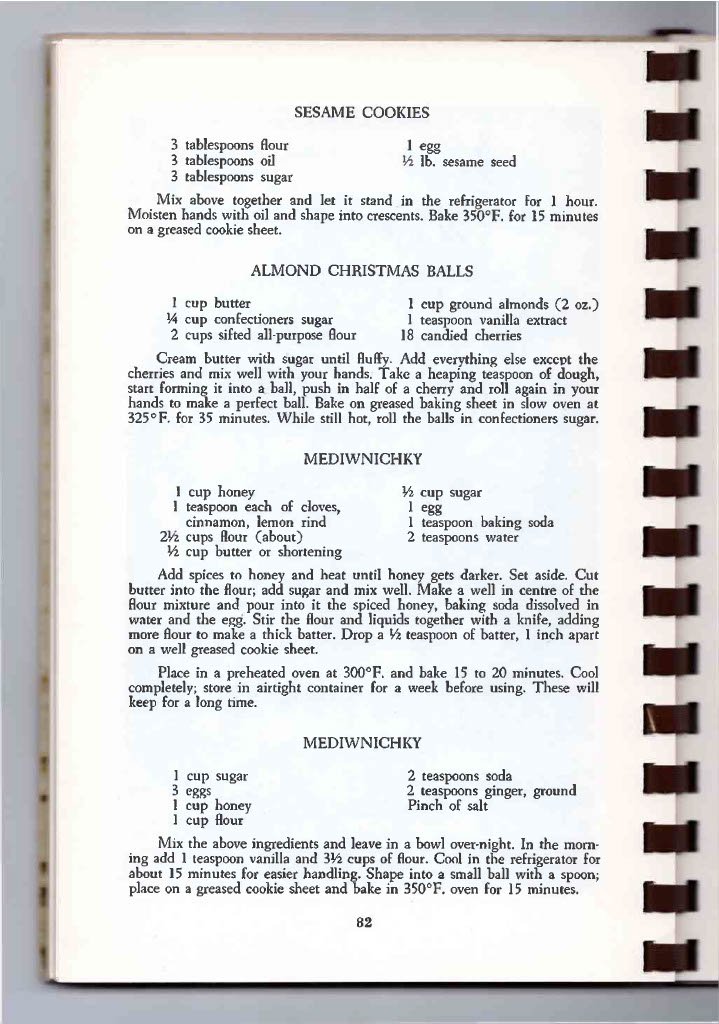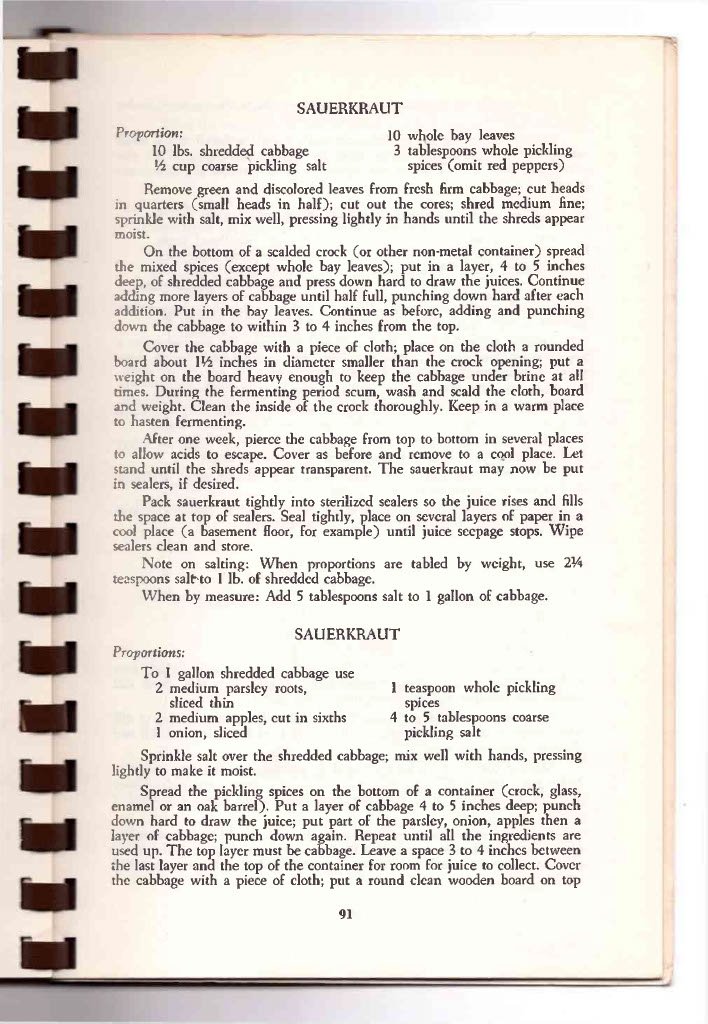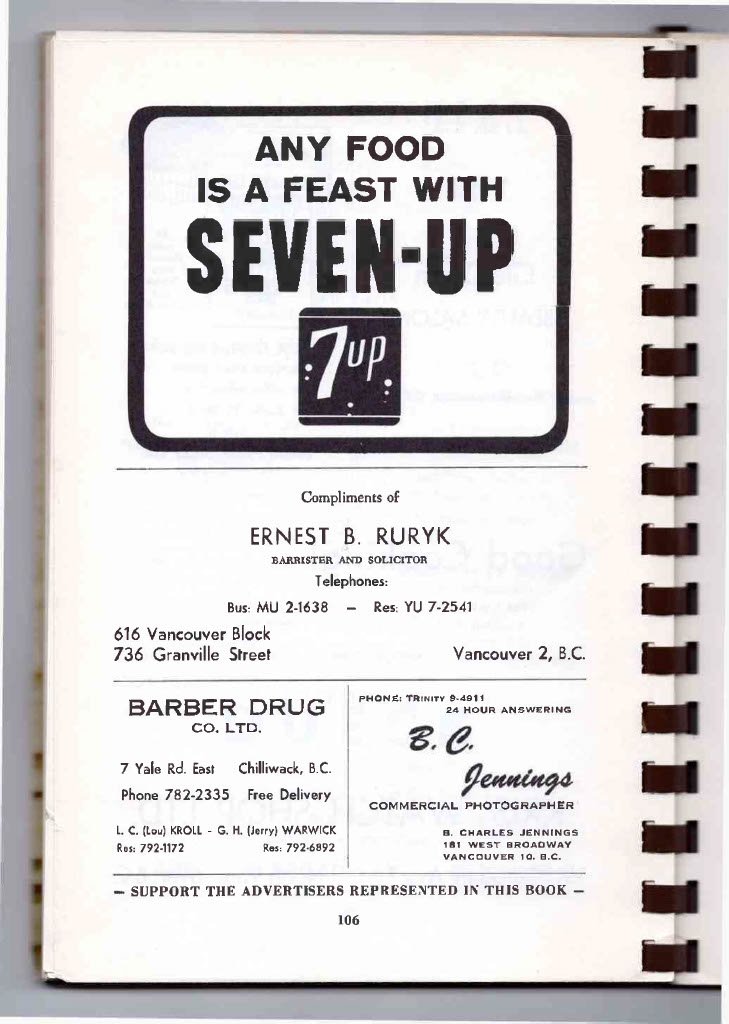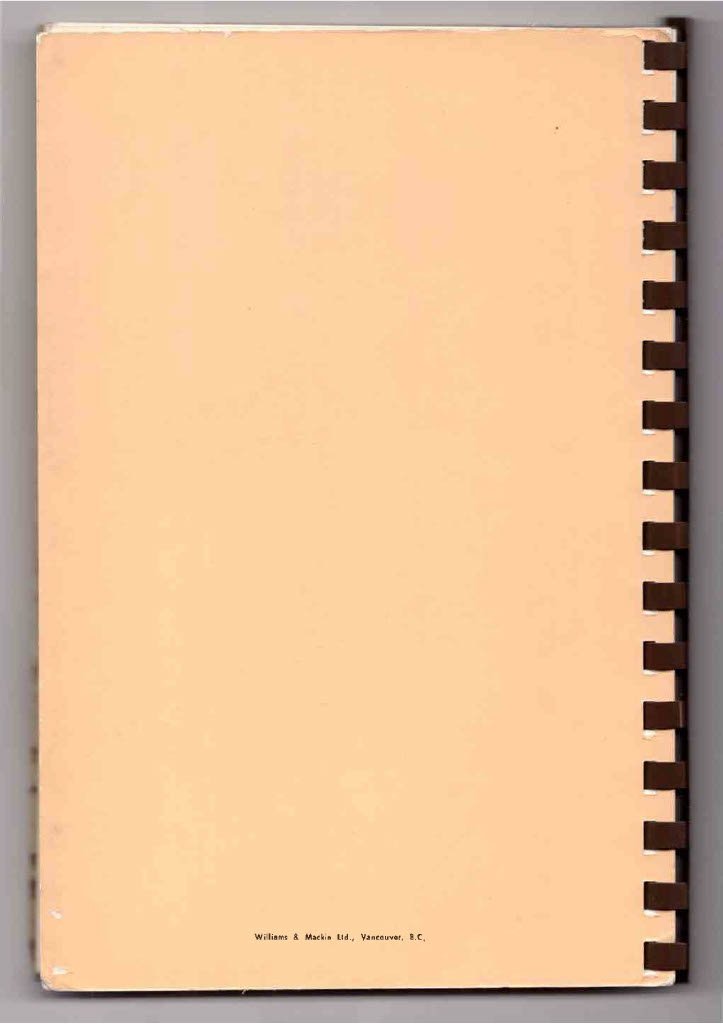Far From Home: Ukrainian Food in Canada
The food and cookbooks of Ukrainian women in Canada are a window into their contributions toward Canadian food culture.
This work is from the upcoming exhibit Memories of Home: Immigrant Culture and Cooking in Canada, part of the What Canada Ate project at the University of Guelph. For my contribution to this project, I researched and wrote about A Book of Recipes: Ukrainian Traditional and Modern Favourites, housed in the Canadian Culinary Collection at the University of Guelph.
A Book of Recipes: Ukrainian Traditional and Modern Favourites, published by the Lesia Ukrainka branch of the Ukrainian Women’s Association of Canada (UWAC) in 1965 to celebrate the organization’s 30-year anniversary.
Introduction
In 1965, the Lesia Ukrainka branch of the Ukrainian Women’s Association of Canada (UWAC) celebrated a significant milestone: the 30th anniversary of their Vancouver-based offshoot of the nationwide women’s group. Part of their 30-year celebrations was the gathering of recipes from its members, which would go on to be published in a 106-page book called A Book of Recipes: Ukrainian Traditional and Modern Favourites.
The book is divided into tidy sections and takes the reader through an array of the hearty and often ambitious recipes of Ukraine. It represents the food that Ukrainian-Canadian women were making, and a snapshot into the lives of Ukrainian women in the late 1960s. The changing social landscape influenced what Canadian women were cooking, and how they were cooking it. The recipes in this book demonstrate the post-war hybrid food culture: they are representative of both the traditional housewife and her role as chief cook and manager of household food, as well as the emerging image of the working woman, who still did most of the cooking, but was increasingly reliant on simpler techniques and the convenience of commercial foodstuffs. Here the title is apt: the book is full of recipes that speak to traditional home cooking, and those that have been reworked to appeal to the modern homemaker of the late 1960s.
Most importantly, the book expresses the Ukrainian pride of its contributors, women who have made Canada home while maintaining the food traditions and rituals of their celebrations. As readers, we are invited to bake up a batch of mediwnichky (spiced honey cookies) or prepare a feast-like, 13-dish Easter Breakfast, and celebrate right along.
about the Authors
This cookbook was not the work of one person, but the collective efforts of 79 women who were members of the Lesia Ukrainka branch of the Ukrainian Women’s Association of Canada in Vancouver, B.C., and the book was published by the same branch
Founded in Saskatoon in 1926, the UWAC was created to preserve and nurture Ukrainian culture while highlighting the significant contributions of Ukrainian traditions to the national culture of Canada. As a lay organisation of the Ukrainian Orthodox Church, the UWAC has, throughout its 96-year history, supported Ukrainian women across Canada through times of want and plenty, and across changing cultural, economic, and political climates.
For the Lesia Ukrainka branch, their focus was Vancouver and the surrounding suburbs. In 1965, more than 35,000 Ukrainians made their new homes in British Columbia.
One contributor was Luba J. Kutt, the chairwoman of the cookbook committee. Her 2013 obituary described her as “a gracious hostess, with a skill and passion for cooking and presentation which brought delight to those fortunate to share her table.” After the death of her husband in 1970, she raised her four children alone, and we can imagine she served many of the recipes in the book on her own family table.
Cooking Up History
From A Book of Recipes: Ukrainian Traditional and Modern Favourites. I love how bountiful and festive this table looks!
Ukrainian immigrants have left an indelible mark on Canada’s west. It is visible in the immediately recognizable architecture of the domed Ukrainian churches, lime-washed buildings, and houses painted in shades of blue and green that dot Ukrainian settlements throughout Western Canada. It was in these settlements that Ukrainian women sustained their food traditions, which would go on to permeate surrounding communities and become part of the food culture of Canada. It is a cuisine for sharing: with families both immediate and extended, and with the broader community, as demonstrated in the book’s acknowledgements: “The executive of the Lesia Ukrainka, Vancouver Branch of the Ukrainian Women’s Association of Canada take great pleasure in presenting to the public in general this Cook Book.”
A Book of Recipes: Ukrainian Traditional and Modern Favourites is a fascinating primary source that allows us to examine the intersection of the female Canadian homemaker and the immigrant community of Ukrainians in mid-1960s Canada. This history of Ukrainian women in Canada begins much earlier, with early twentieth century conflicts bringing large populations of Ukrainian immigrants to Canada, changing and influencing our cultural makeup, and our food culture. Throughout the 1920s, 30s and 40s, immigrant women and their families emigrated to Canada and settled mostly in the Prairies, but also in northern Ontario, and as we can discern from this cookbook, eventually formed communities in Vancouver as well.
First published in 1965, the recipes in this cookbook speak to a particular time in Canadian history, a period that straddled many years of long-standing, normative traditions of female domesticity, and the beginnings of feminism’s interrogation of these traditions. During the late 1960s and 1970s, women began joining the workforce in numbers not seen since World War Two, and with less time at home to cook, meals needed to be fast and simple. Yet we cannot apply the history of Canadian women in general to that of Ukrainian women without acknowledging the cultural differences that made the feminist experience different for immigrant women. By privileging gender over ethnicity, it ignores the fact that cultural and social changes were happening in ways unique to different ethnic communities, and the Ukrainian community was no different. It is important to note that political tensions in early twentieth century Ukraine had left many Ukrainians with a fractured sense of identity, and it was up to women in Ukrainian communities in Canada to perpetuate and preserve their traditions, and their sense of self, in their new country. The forming of women’s groups such as the Ukrainian Women’s Association of Canada was one of the ways to celebrate Ukrainian traditions, and their cookbook expressed the importance of Ukrainian cuisine as a way of expressing their cultural values, traditions, and celebrations.
Throughout the waves of Ukrainian migrations, women were responsible for the procurement and preparation of the food their families ate. Their food and recipes helped to link Ukrainians to their past, while reinforcing their traditions and customs in Canada. As they became part of both the social and cultural fabric of their new country, their foods and traditions influenced Canadian food culture. Many Canadians now enjoy pierogi, sautéed with onions and with a dollop of sour cream or cook up a comforting meal of Chicken Paprika.
Traditional Dishes for Ukrainian Christmas Eve. From A Book of Recipes: Ukrainian Traditional and Modern Favourites.
Cooking for special occasions in Ukrainian culture can be a days-long affair, as evidenced by this extensive menu.
At first glance, the book reveals this tension between established traditions and these new movements toward women’s liberation from full-time domesticity. We see packaged and convenience foods, helpful timesavers for the busy working woman, making their way into traditional recipes. On page 32 recipe for nalysnyky (small pancakes rolled around a cottage cheese filling and layered in a casserole dish with melted butter) calls for Aunt Jemima Pancake Mix to make the pancakes, and a recipe for Creamy Chicken on page 37 uses canned cream of mushroom soup. Food culture of the 1960s and 1970s is recognisable because of these packaged food additions, and Ukrainian women used them as well. Where would these decades be without Jellied Shrimp Salad (pg. 48) Carrot Jell-O Salad (Pg. 49) or the Angel Salad (page 49) containing sour cream, coconut, canned mandarin oranges, marshmallows, and canned pineapple?
A mid-century feast, laid out with traditional Ukrainian specialities, including beautifully decorated psanky. From A Book of Recipes: Ukrainian Traditional and Modern Favourites.
Alongside the simpler recipes using convenience foods to save time, are those that would have taken many hours to make. Despite women entering the workforce, there was still the expectation that she would cook for traditional holidays and large family gatherings, and there are complicated recipes throughout the book, including pierogi made from scratch, or cakes with several different layers. Yet it is important to note that immigrant Ukrainian women were not limited to a role only in the private sphere; they were expected—and encouraged—to engage in cultural exchanges with their new country, carefully balancing both the dissemination of Ukrainian culture while simultaneously assimilating into their Canadian one. Their membership in Lesia Ukrainka is an example of how Ukrainian women navigated their private and public spheres, and the recipes chosen as their favourites for the 30th anniversary cookbook, capture how they continued to embrace the traditional foods of their homeland alongside acceptance of the foods of their new home in Canada.
Sample Recipes
The ingredients and techniques in this recipe for Twists, along with the very basic title speaks to the relative simplicity of most of the recipes in this cookbook, which were created by, and for, Ukrainian female homemakers in the late 1960s. The ingredients are simple staples that most women would have on hand in their kitchens: butter, eggs, flour, yeast, sugar, and cinnamon. Thanks to the photo, we can see that Twists are little pastries, made of yeast dough, layered with cinnamon and sugar and folded puff-pastry style before being cut into strips, twisted, and baked. The simple ingredients paired with the folding and cutting created an attractive treat that would have been a nice addition to a cookie tray at Christmas, (along with other festive cookies and pastries, of which there are many recipes in the book) but simple enough to enjoy anytime with coffee or tea.
Smothered Chicken a la Paprika is another recipe that would have been a relatively easy family meal, while being fancy enough to serve on a Christmas buffet. Traditionally a Hungarian dish, it was clearly a staple in Ukrainian households, as there are several versions of a Chicken Paprika recipe in the book. This recipe demonstrates the versatility shared by many of the dishes in the book. The 1960s housewife would be cooking daily for their family but would also be entertaining family members and friends on the weekends, or during traditional holidays, so a recipe like this could easily do double-duty. The ingredients are simple and would have been accessible to 1960s Vancouver home cooks: chicken, onions, flour, cream, dill, and of course, paprika, which was used both to add colour to the chicken during the browning process and to flavour the finished sauce. There is no photo of this dish, but the saucy chicken, enriched with sour cream and garnished with fresh dill, would have been an attractive and hearty home-cooked meal for Ukrainian families.
Helen Gagan
An original letter from Mrs. W Lawrynicek to Toronto food writer Helen Gagan was found tucked into the cookbook
The original owner of this cookbook was Helen Gagen who, at the time of the book’s second printing in 1970, was the food editor of the now-defunct Toronto Telegram newspaper. How do we know? Tucked inside the cookbook is a letter to Gagen from Mrs. W. Lawrynicek who was a member of the Toronto branch of the Ukrainian Women’s Association of Canada. In the letter, Lawrynicek thanks Gagen for her article on Ukrainian Christmas “It was especially kind of you…to devote your personal time and energy to the preparation of such an excellent literary composition…all who read it enjoyed it.” At the bottom is a p.s. where she says, “I am sending a book of Ukrainian recipes.”
One of Helen Gagen’s recipe contributions to The Globe and Mail, December 1st, 1982
It’s interesting to think about how the book made its way from Mrs. Lawrynicek, to Helen Gagen, who would eventually donate her collection of cookbooks and food writing to Culinary Collections here at the University of Guelph.
You can peruse the entire book here.
Sources
Avakian, Arlene. From Betty Crocker to Feminist Food Studies: Critical Perspectives on Women and Food /. Amherst: University of Massachusetts Press, 2005.
“British Columbia”. Encyclopaedia of Ukraine. http://www.encyclopediaofukraine.com/display.asp?linkpath=pages%5CB%5CR%5CBritishColumbia.htm
“Display Ad 28 — no Title.” The Globe and Mail (1936-), Nov 21, 1963.
Draper, Paula, Franca Iacovetta, Robert Ventresca. “The Ukrainian Impress on the Canadian West.” In A Nation of Immigrants: Women, Workers, and Communities in Canadian History, 1840s-1960s. 128-163. Edited by Paula Draper, Franca Iacovetta, and Robert Ventresca. Toronto: University of Toronto Press, 2020.
Gagen, Helen. “KITCHEN MAGIC.” Chatelaine, 04, 1977, 82-83, 94-96, 98, 100,
Gagen, Helen. “RECIPE OF THE WEEK: TREAT OF VERSAILLES.” The Globe and Mail (1936-), Dec 01, 1982.
Gannon, Mo. “HELEN GAGEN MAGEE.” The Globe and Mail, May 07, 1998.
HELEN, GAGEN MAGEE. “Lives Lived.” The Globe and Mail (1936-), May 07, 1998.
Iacovetta, Franca, Valerie J. Korinek, and Marlene Epp. “Edible Histories, Cultural Politics: Towards a Canadian Food History.” Toronto: University of Toronto Press. 2012.
Luciuk, Lubomyr Y., Stella M. Hryniuk, and Ukrainian Canadian Centennial Committee. Canada’s Ukrainians: Negotiating an Identity. Published in association with the Ukrainian Canadian Centennial Committee by University of Toronto Press, 1991.
Members of the Ukrainian Women’s Association of Canada, Lesia Ukrainka Branch. A Book of Recipes Ukrainian Traditional and Modern Favourites. Vancouver: Ukrainian Women’s Association of Canada, Lesia Ukrainka Branch, 1965. TX715.6. B66. Jean Paré Collection. Archival and Special Collections. University of Guelph, Guelph, ON.
Obituary of Luba Kutt. https://www.dignitymemorial.com/obituaries/burnaby-bc/luba-yaremchuk-5591160
“Other 43 — no Title.” The Globe and Mail (1936-), Aug 25, 1982.
Parasecoli, Fabio. “Food and Gender.” Food And Drink in History. 2019. Accessed November 18, 2022. http://www.foodanddrink.amdigital.co.uk.subzero.lib.uoguelph.ca/ResearchTools/Essays/Parasecoli
